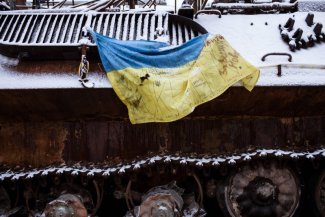Surviving the winter: Ukraine ahead of an energy crisis

The massive Russian missile attacks which began in October have led to a serious failure of Ukraine’s entire energy system. In the largest attack, on 23 November, the majority of power plants and combined heat and power plants were damaged, and numerous residential buildings and healthcare facilities were destroyed. Blackouts were seen in many cities, including Kyiv. The duration of the power outages ranged from several hours to a few days. There were also interruptions in the supply of heat and water. The operation of nuclear, thermal and hydropower plants was suspended, and rail transport stopped. The authorities in charge of the energy grid are promptly restoring the functionality of the system. However, these are provisional actions and cannot guarantee its overall stability. The government has also taken measures to alleviate the severity of the consequences which the shelling will have for the public, by creating ‘heating points’ throughout the country. However, these are far from meeting the overall needs.
The approaching sub-zero temperatures are bringing Ukraine to the verge of a humanitarian catastrophe, and the likelihood of further attacks will only exacerbate this crisis. Some representatives of the city authorities are openly discussing the need to evacuate some residents for the winter season. The seriousness of the situation is confirmed by the World Health Organization (WHO), which forecasts that up to 2–3 million Ukrainians will leave their homes in search of better conditions for the winter. The Ukrainian public is therefore facing another challenge and will be forced to struggle to survive in the coming months. However, so far, Ukrainians have reacted to the Russian attacks and crimes primarily by a growth in patriotic attitudes and by strengthening mutual solidarity.
The scale of the destruction
The massive missile attack on 23 November (Russia fired 78 missiles and drones, most of which were cruise missiles capable of destroying precise targets) caused a temporary failure of basically the entire Ukrainian energy supply system. At least 16 energy infrastructure facilities – combined heat and power plants, hydroelectric power plants and substations in the capital and in the Vinnytsia, Lviv, Zaporizhzhia, Khmelnytskyi and Poltava oblasts, as well as in Odesa and many other cities – were damaged and taken out of service. All operating nuclear power plants that are controlled by Kyiv have been disconnected from the grid for safety reasons. The shelling also affected Moldova, which is connected to the Ukrainian power grid; electricity was cut off in half of the country's territory. The Russians did not only shell energy facilities, but also residential buildings, hospitals and schools. In the attacks on 23 November, at least ten people were killed and dozens were injured. Many people lost their homes.
Emergency services are quickly repairing the damaged networks and buildings, but these are mostly makeshift repairs. In fact, the operation of the entire power supply sector has been destabilised. According to data available on 29 November, the power deficit reached 30%, and energy supplies were restricted in all regions (the previously announced schedules of stabilisation shutdowns are no longer in effect, emergency power outages occur all the time, including in Kyiv). The energy sector requires huge technical support from the West: spare parts for the renovation of facilities, power generators and increased fuel supplies are needed. The situation is additionally complicated by the high likelihood of further missile attacks, which will cause new blackouts.
The looming humanitarian catastrophe
The consequences of the massive repeated missile attacks include a severe deterioration of the already extremely difficult living conditions in most Ukrainian cities and villages. The repeated blackouts in the last two months are affecting the residents, but are also disrupting the work of critical infrastructure and the functioning of the weakened economy (industry, retail chains, service providers, etc.). In addition to power outages, interruptions in water supplies, some lasting over a day, have been particularly problematic for Ukrainians. The blackouts, which in many places continued for more than one or even several days, have complicated the functioning of critical infrastructure, including hospitals.
The dramatic situation has been confirmed by the WHO, which has stated that Ukraine is on the brink of an unprecedented energy crisis, and the physical and mental health of its residents may deteriorate drastically. According to the WHO, 10 million Ukrainian citizens are at risk of mental disorders, including acute stress, depression and post-traumatic stress disorder (PTSD). The WHO reports that the Ukrainian healthcare service is going through its biggest ever crisis: healthcare facilities have been shelled a total of 700 times, and the blackouts make it impossible to perform many life-saving procedures.
The government’s remedial actions
The government has been trying to remedy the consequences of the blackouts: about 4,000 heating points (called ‘invincibility centres’) have been established across the country. They are open around the clock, and can accommodate from varying numbers of people, from dozens up to 500 people. They offer heating, water, electricity, Internet and mobile communication, the opportunity to charge devices as well as medicines and food parcels. Around 160 of these have been created in Kyiv and 50 in Lviv. The government has also liberalised the rules for importing power generators and charging stations to Ukraine (they have been exempted from customs duties and VAT). According to Prime Minister Denys Shmyhal, about 8,500 generators are currently imported into Ukraine every day.
Government institutions are trying to adapt to crisis conditions and set new rules of operation. The National Bank of Ukraine has announced the creation of a nationwide network with other banks using backup power sources (“Power Banking”) to which about a thousand branches of various banks will be connected throughout the country.
The government in Kyiv has stepped up its appeals for increased Western support, including the supply of air defence systems, power generators and the spare parts needed to repair critical infrastructure, and for further financial resources and humanitarian aid. Ukraine's partners have responded to these calls by sending additional batches of generators to the country. The European Parliament, along with the Eurocities network of more than 200 European cities, has launched the ‘Generators of Hope’ campaign. There are plans to send at least several hundred generators, including industrial ones, as part of the campaign. Earlier, under the EU Civil Protection Mechanism, 17 member states, including Poland, delivered 500 generators to Ukraine. The European Commission is also planning to create an ‘energy centre’ in Poland to coordinate the collection of aid from third parties (including the G7) and deliver it to Ukraine. Individual countries are also providing support: Germany has reportedly sent at least 2,430 generators and declared it would donate EUR 40 million for the modernisation of the Ukrainian energy system, and the German Society for International Cooperation (GIZ) is planning to purchase 1,000 more generators for Ukrainian municipalities. Lithuania has allocated EUR 3 million for the reconstruction of the damaged energy infrastructure and has announced a further EUR 2 million in aid. A batch of power generators and solar lamps worth US$ 2.57 million will be provided by Japan. The Polish government sent a batch of power generators worth tens of millions of zlotys, and numerous Polish cities are also helping.
The government is trying to calm down the residents by assuring them that there will be no complete blackout in the country, and only periodic shutdowns are possible, which will be remedied by actions taken by Ukrenergo and the energy services. Representatives of the government and the Presidential Administration emphasise that the situation is difficult but under control, and point out that it will not be necessary to leave the country. In his strategic communication (including daily speeches), President Volodymyr Zelensky is trying to emphasise the fortitude manifested by the Ukrainian public and the need to make sacrifices to achieve victory.
However, the statements from local authorities and energy companies reveal the real scale of the crisis. On 16 November, the mayor of Ivano-Frankivsk admitted that it may be necessary to evacuate part of the population. He appealed to the residents to leave the city for the winter, if possible (Ivano-Frankivsk is also a temporary place of residence for about 145,000 internal refugees). In turn, the mayor of Kyiv warned that the coming winter would be the hardest for Ukraine since World War II, and said that it might be necessary to evacuate some of Kyiv’s residents (he later clarified that he meant moving to the suburbs or to smaller towns). In turn, the CEO of Ukraine’s largest energy company, DTEK, stated that, given the scale of damage to the power lines, it would be advisable for some citizens to leave the country, since this would ease the burden on the entire production and transmission system and improve the supply of electricity for war needs.
The struggle for survival: the Ukrainian public in the face of the crisis
So far, Ukrainians have shown steadfastness in the face of Russian aggression, losses and destruction, as they believe that there is no alternative to continuing armed resistance. A poll conducted by the Kyiv International Institute of Sociology at the end of October, after the first massive missile attack, showed that 86% of Ukrainians support continuing the fight against the aggressor (10% want ceasefire talks with Russia). In turn, according to a Gallup survey conducted in mid-October, 70% of respondents would choose fighting until total victory, which also means regaining control over Crimea. The dynamics of public sentiment shows that every violent attack or exposure of the crimes committed by the Russian Army only fuels hatred towards Russia among the Ukrainian public and never makes them want to give up their struggle. Public morale has also been strengthened by the recent successes of the Ukrainian Armed Forces – they have strengthened the belief that Ukraine is able to win this war.
The Ukrainian public has also repeatedly demonstrated their ability to respond flexibly, creatively and in the spirit of solidarity. Thanks to this they have been able to survive in the most difficult conditions. Even after the most recent unprecedented wave of missile attacks on 23 November, there were reports on social media networks that Ukrainians had become accustomed to the shelling and were trying to continue their normal lives, sometimes ignoring safety rules. The concern which Ukrainians feel about their own future is overshadowed by the hatred they feel towards Russia and their determination to survive this winter, which is seen as a decisive test of strength. The government (state, municipal and communal authorities), entrepreneurs and ordinary residents alike are trying to adapt to the existing conditions. Energy efficiency is becoming the new norm: the media and websites are filled with advice and tips regarding this issue, and Ukrainians are outdoing each other with ideas on how to save electricity as effectively as possible.
It remains an open question whether these attitudes will last over a longer period and how they will be affected by what is likely to prove to be the hardest winter in the post-1945 history of Ukraine. The unprecedented scale of the energy crisis is forcing the Ukrainian state to consider the need to face a humanitarian catastrophe. This may give rise to further waves of refugees – both IDPs (leaving large cities to move to smaller towns) and those wanting to go abroad (men of conscription age are still not allowed to leave the country). At present, the statistics of the movement of people on the Ukrainian-Polish border reveal a slight increase in the number of people entering Poland. Between 15 and 22 November, the number ranged between 19,000 and 22,000 daily, and after 23 November it was 21,000 to 25,000 (with about 20,000 people entering Ukraine every day from Poland). However, considering the very likely continuation of Russian precision missile attacks on energy facilities in Ukraine, the long-term shortages of electricity, heat and water during cold weather may cause a larger flow of refugees in the coming months. Public sentiment may also be undermined and criticism of the Ukrainian government may intensify if it proves unable to ensure the basic conditions for survival.




